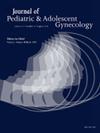3. Cardiovascular Risk in Females with Endometriosis
IF 1.7
4区 医学
Q3 OBSTETRICS & GYNECOLOGY
引用次数: 0
Abstract
Background
Individuals with endometriosis are at higher risk of cardiovascular (CV) disease, hypertension, high cholesterol, and atherosclerosis. While CV disease is rare in young people, surrogate markers such as the pulse wave velocity (PWV), a measure of arterial stiffness, can predict future CV dysfunction. We sought to determine if females with endometriosis had elevated PWV values, and thus increased CV risk, compared with healthy control subjects. We also investigated whether additional predictors of future CV risk correlated with PWV measurements.
Methods
At the baseline visit of a multi-site, randomized clinical trial, n=70 females with laparoscopically-confirmed endometriosis and persistent pelvic pain provided health history and anthropometric measures. Blood samples were obtained for measurement of inflammatory markers (hs-CRP, ESR), lipid profiles (HDL, LDL), and hormonal concentrations (estradiol). PWV was collected by using two pressure probes placed at the carotid artery and femoral artery. The time it takes the pressure wave to go from the upstream probe to the downstream probe provides the Pulse Transit Time. PWV is calculated by dividing the distance traveled by the transit time. Previously obtained normative data from n=1455 from healthy controls were used as reference. Generalized linear regression models with adjustments for age, endometriosis stage and BMI were developed to test the associations of interest. We had local IRB approval.
Results
Of the n=70 participants, n=63 (median (interquartile (IQR)) age 25.3 (13.2) y, range 16.1–39.2y)) had PWV scans adequate for analysis. All were using hormonal therapy: 10 (15.9%) combined-hormonal contraception, 27 (42.9%) oral progestin, 31(49.2%) LNG IUD, and 11 (17.5%) other. Participants were excluded for other CV disease risk (n=2 high cholesterol, n=1 hypertension). Demographic and clinical characteristics are summarized in Table 1. About 30% of participants had stage I endometriosis. Median (IQR) PWV was 5.1 (1.2) m/s, lower than normative values for this age range (median=6.1-6.4 m/s for ages < 30 – 39). Respective associations between PWV and hs-CRP, ESR, HDL, and estradiol were nonsignificant (p> 0.15). LDL was positively associated with PWV (regression coefficient (β)=0.02, 95% CI=[0.01, 0.03], p< 0.01).
Conclusions
Females with endometriosis had lower PWV measurements compared to age-matched control subjects. LDL was positively associated with PWV; other CV risk markers were not. In this sample, young females with endometriosis did not demonstrate early signs of increased CV risk as measured by PWV. Future studies should investigate the impact of duration of disease and use of hormonal treatment on these findings.
3. 子宫内膜异位症女性的心血管风险
背景子宫内膜异位症患者患心血管(CV)疾病、高血压、高胆固醇和动脉粥样硬化的风险更高。虽然心血管疾病在年轻人中很少见,但替代指标,如脉搏波速度(PWV),一种衡量动脉硬度的指标,可以预测未来的心血管功能障碍。我们试图确定与健康对照者相比,子宫内膜异位症的女性是否有升高的PWV值,从而增加了CV风险。我们还研究了未来CV风险的其他预测因素是否与PWV测量相关。方法在一项多地点随机临床试验的基线访问中,n=70名经腹腔镜确诊的子宫内膜异位症和持续盆腔疼痛的女性提供了健康史和人体测量数据。采集血液样本用于测量炎症标志物(hs-CRP, ESR),脂质谱(HDL, LDL)和激素浓度(雌二醇)。在颈动脉和股动脉处放置两个压力探头收集PWV。压力波从上游探头到下游探头所花费的时间就是脉冲传递时间。PWV的计算方法是将行进的距离除以穿越时间。以健康对照中n=1455例先前获得的规范数据为参照。开发了广义线性回归模型,调整了年龄、子宫内膜异位症分期和BMI,以检验感兴趣的相关性。我们得到了当地IRB的批准。结果在70名参与者中,63名(中位数(四分位数(IQR))年龄25.3(13.2)岁,范围16.1 - 39.2岁)有足够的PWV扫描进行分析。所有患者均采用激素治疗:联合激素避孕10例(15.9%),口服黄体酮27例(42.9%),LNG宫内节育器31例(49.2%),其他11例(17.5%)。排除有其他心血管疾病风险的参与者(n=2高胆固醇,n=1高血压)。人口学和临床特征总结于表1。大约30%的参与者患有I期子宫内膜异位症。中位数(IQR) PWV为5.1 (1.2)m/s,低于该年龄段的正常值(年龄和年龄的中位数为6.1-6.4 m/s;30 - 39)。PWV与hs-CRP、ESR、HDL和雌二醇的相关性均不显著(p>;0.15)。LDL与PWV呈正相关(回归系数(β)=0.02, 95% CI=[0.01, 0.03], p<;0.01)。结论子宫内膜异位症女性的PWV测量值低于同龄对照组。LDL与PWV呈正相关;其他心血管危险指标则没有。在这个样本中,患有子宫内膜异位症的年轻女性没有表现出PWV测量的CV风险增加的早期迹象。未来的研究应调查疾病持续时间和使用激素治疗对这些结果的影响。
本文章由计算机程序翻译,如有差异,请以英文原文为准。
求助全文
约1分钟内获得全文
求助全文
来源期刊
CiteScore
3.90
自引率
11.10%
发文量
251
审稿时长
57 days
期刊介绍:
Journal of Pediatric and Adolescent Gynecology includes all aspects of clinical and basic science research in pediatric and adolescent gynecology. The Journal draws on expertise from a variety of disciplines including pediatrics, obstetrics and gynecology, reproduction and gynecology, reproductive and pediatric endocrinology, genetics, and molecular biology.
The Journal of Pediatric and Adolescent Gynecology features original studies, review articles, book and literature reviews, letters to the editor, and communications in brief. It is an essential resource for the libraries of OB/GYN specialists, as well as pediatricians and primary care physicians.

 求助内容:
求助内容: 应助结果提醒方式:
应助结果提醒方式:


